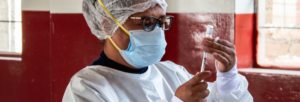Understanding Exposure Risks
August 22, 2022
Learning about how COVID-19 spreads and the factors that can increase or decrease that risk can help you make informed choices.
The questions below are written in past tense to help you assess the likelihood that you were infected when you were around a person with COVID-19. If multiple factors below indicate higher transmission risk, you should follow the steps for what to do if you are exposed.
You can also ask yourself the same questions, but about future interactions with others, to help you decide what prevention actions to take. If multiple factors below indicate higher transmission risk, you should consider adding more prevention actions.
Factors that lower or increase risk of transmission
Length of time: How long were you with the infected person?
Longer exposure time increases the risk of transmission (for example, contact longer than 15 minutes is more likely to result in transmission than two minutes of contact).

Cough or heavy breathing: Was the infected person coughing, singing, shouting, or breathing heavily?
Activities like coughing, singing, shouting, or breathing heavily due to exertion increase the risk of transmission.

Symptoms: Did the infected person have symptoms at the time?
Being around people who are symptomatic increases the risk of transmission.

Masks: Were you or the infected person or both wearing a respirator (for example, N95) or high-quality mask?
If one person was wearing a mask, the risk of transmission is decreased, and if both people were wearing masks, the risk is substantially decreased. Risk is also lower if the mask or respirator is a type that offers greater protection.

Ventilation and filtration: How well-ventilated was the space?
More outdoor air can decrease the risk of transmission. Being outside would be lower exposure risk than being indoors, even with good ventilation and filtration; both of those options would be lower risk than being indoors with poor ventilation or filtration. See the Interactive Home Ventilation Tool.

Distance: How close was the infected person to you?
Being closer to someone who is infected with COVID-19 increases the risk of transmission. Crowded settings can raise your likelihood of being close to someone with COVID-19.

To learn more, please visit https://www.cdc.gov/coronavirus/2019-ncov/your-health/risks-exposure.htm